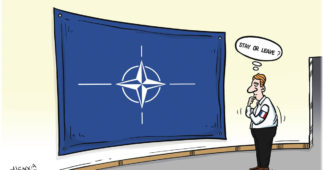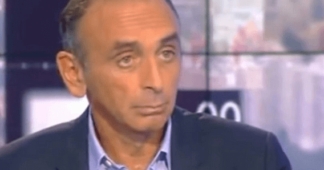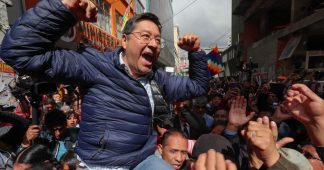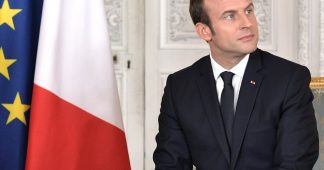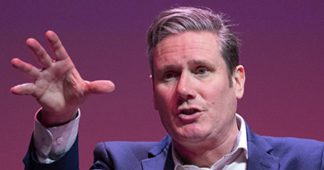The war in Ukraine, first and foremost, has decentred the general debate and, above all, has allowed Macron to reassert his presidential stature. On the left, the conflict has exacerbated already strong ideological divisions, and the gaps in the polls have widened.
By Gala Kabbaj
07 Apr 2022
The week after the Russian army invaded Ukraine, the incumbent presidential candidate gained eight percentage points in the polls. Widely acknowledged as the head of the army and diplomacy, Macron has chosen not to take part in many of the activities a regular campaigning candidate would undertake and refuses to debate with other candidates. The war in Ukraine has also contributed to discrediting right-wing candidate Éric Zemmour, known for being close to Putin. The traditional left fractions (the Socialist Party and Communist Party) have seemingly failed to create momentum around their candidates. The Green Party is holding its ground but stagnating at around 5% in the polls. The candidate from La France insoumise, who stands at 14%, appears to be the only one on the left who can make it to the second round. However, the left has not yet decided to come together to prevent a second round between liberals and the far right.
There is little doubt around the re-election of Emmanuel Macron, but the question of who will come in second place remains decisive. Indeed, the prospect that the sequence of political debate and action between the two rounds could turn towards the left rather than the extreme right is exciting. It would allow important issues to be addressed, including social inequalities, public services, ecology, gender inequalities and racism, among others. Even though candidate Jean-Luc Mélenchon is building momentum among the electorate, the left continues to be divided between six candidates and shows significant levels of resistance. What are the causes of this?
Many of the disagreements on the left during this campaign are, in reality, attempts by the candidates to position and distinguish themselves. However, deep divisions between the candidates and their supporters do persist and help to explain the scattering of the left bloc.
The opposition between radical and moderate fractions continues to structure the left. Recently, the positions on the war in Ukraine have exacerbated these deep ideological divisions.
The positions taken by the environmentalist candidate Yannick Jadot make him the biggest warmonger on the left. From the first day of the Russian invasion, Jadot (with around 5% in the polls) was already calling for the delivery of weapons to Ukraine. Since then, he has continued to multiply maximalist statements on the sanctions to be taken against the Russian regime. The candidate believes that the EU’s military capabilities are insufficient and has not totally ruled out the possibility of sending troops directly to fight. This clashes with the pacifist line of his party. Many leaders and elected officials of the Green Party have expressed their disagreement with the candidate, preferring talk of ceasefire, de-escalation, and putting diplomatic, political and economic pressure on Russia. However, in pursuing this line, Jadot wants to position himself as both a more “courageous” candidate than Macron and as Mélenchon’s main opponent. When it comes to his left-wing political opponent, Jadot is quick to suggest Mélenchon is complicit with Putin.
The socialist candidate, Anne Hidalgo, who has around 2.5% in the polls, follows rather closely in the footsteps of Jadot. She does not entertain the question of leaving NATO, but is ready to help with the armament of Ukraine and in favour of a strict embargo on Russian gas.
Within the radical left, Jean-Luc Mélenchon (La France Insoumise; around 13% in the polls) and Fabien Roussel (French Communist Party, PCF, around 3% in the polls) defend de-escalation and non-alignment. Mélenchon goes further, also promoting France’s exit from NATO, unlike his communist counterpart. The PCF, whose history is deeply rooted in the fight for peace and the struggle against imperialism, has not turned its back on its roots. However, their candidate Roussel believes that the seriousness of the situation means the debate on leaving NATO should not be held during the crisis.
Media coverage of the election campaign generally tends to pay attention only to candidates with a strong voter base. For this reason, Phillippe Poutou (New Anticapitalist Party) and Nathalie Artaud (Workers’ Struggle) are rarely interviewed about the war in Ukraine. Both Trotskyist candidates represent anti-imperialist and pro-peace positions (withdrawal from NATO, welcoming all refugees). Both Poutou and Artaud have around 0.5% in the polls, which makes it difficult to study their electorate’s characteristics. Still, what we do know is that Poutou’s and Artaud’s voters are highly politicised and motivated to go to the polls.
Ideologically, other subjects divide the left-wing candidates and their voters, among them the nuclear issue. On this subject, the division between radical and reformist parties is not relevant. For Mélenchon, an energy bifurcation is necessary: the complete exit from nuclear power by 2045 and the transition to 100% renewable energy. The socialist candidate Hidalgo and the environmentalist candidate Jadot are also in favour of a nuclear phase-out, but in a more gradual way. Roussel, for his part, offers a space on the left that is favourable to nuclear power, to “fight against expensive energy and ensure a decarbonised industry”. While some environmentalists support this position and see nuclear power as an opportunity to decarbonise the economy, the danger of nuclear power and the total absence of solutions for recycling nuclear waste act as a base for a hegemonic position on the left that is firmly against nuclear power. It is important to underline that France’s energy mix is made up of around 40% nuclear power, 28% oil, 16% natural gas, and only 14% renewable energy.
However, voters’ unwillingness to rally behind a single candidate can also be explained by the diversity of their social origins. Voting intention surveys allow us to identify some disparities.
Jadot and Hidalgo, despite the small samples available, seem to share a fairly similar electoral base, and their attempt at a joint candidacy in the winter of 2021 may have proven successful. Jadot enjoys support among the young and those over 65 years old. He is most popular among executives, retired people and the unemployed in urban areas. From the point of view of income, his main support comes from the middle classes (those with a monthly income of 2050-2650 euros).
Hidalgo has fewer supporters among young people but her electorate resembles that of Jadot on other points. However, there is one particularity. As Mayor of Paris, her strongest support is in the capital. She is weaker in other urban communes in France and almost absent in rural areas.
Roussel, with 3.5% of the polls, attracts a mainly male vote (securing 5% of the vote among men and 2% among women), specifically among those aged 50-64 who are still professionally active. His voters fall mainly in the modest categories of small public employees. From the point of view of partisan proximity, 9% of people who feel close to the Socialist Party intend to vote for the communist candidate.
Jean-Luc Mélenchon manages to secure the vote of a younger electoral base (he is the most popular candidate among voters aged 18-24 years old). From a social point of view, he scores high among both executives (18%) and workers (20%). His supporters are also educated but with low incomes.
This initial data on voting intentions allows us to roughly sketch a portrait of left-wing voters but is lacking in precision. In order to better understand the dynamics and resistance that the candidates on the left have provoked, targeted population surveys provide additional information. The literature on electoral sociology shows a renewed profile of the left-wing electorate. Distanced from the white male proletarian, these studies show that new social bases are found among labour movements, but this is not an exclusive criteria: immigrant groups, those living in precarity, sexual and gender minorities and young people constitute a dynamic support base for the left.
Thus, two surveys allow us to clarify this analysis: one, commissioned by the newspaper Jeune Afrique and dated March 2022, analyses the voting intentions of French people of African origin. The second analyses the vote of priority of (i.e., disadvantaged) neighbourhoods in the suburbs in January 2022.
These surveys show that both these population groups lean strongly towards the left—and even the radical left—but are more likely to abstain than the rest of the population (70% of the electorate says they intend to vote in April 2022, but that figure is only 55% among groups of African origin). In priority suburban neighbourhoods, 46% intend to vote for a radical left-wing option and 10% for the government left. The moderate left seems to be having trouble finding a place in these groups: candidate Jadot scores 3% in this same population group while Mélenchon secures 37% of intended votes.
This trend is confirmed in groups of African immigrants, where Mélenchon gets 36% of the votes, Jadot 5%, Hidalgo 3% and Roussel 3%. On the left, only Mélenchon seems to find an echo among the popular electorate and those of immigrant origin. The prominence of the candidate from La France insoumise was already visible 2017, but the anchoring of the radical left in these groups seems to have been accentuated. However, while the extreme right is almost absent, Macron retains a fairly high percent of the intended vote of people of African origin, at around 27%. Here, there is a class effect at play: the more voters who occupy managerial positions, the stronger the Macron vote. Mélenchon experiences the opposite effect, securing his highest score among workers (40%). But in a hypothetical Macron-Mélenchon second round, among this population the Mélenchon would win with 51% of the votes.
While many citizens have called for a single candidate, it is clear that the ideological differences between the left-wing candidates remain numerous and that the different parts of the electorate have partially antagonistic social positions. However, Jean-Luc Mélenchon’s broadening social base gives a slim possibility of reaching the second round and confirms that the left wins votes when it addresses a strong discourse of social proposals while also taking into account struggles against all racial and sexual discrimination
We remind our readers that publication of articles on our site does not mean that we agree with what is written. Our policy is to publish anything which we consider of interest, so as to assist our readers in forming their opinions. Sometimes we even publish articles with which we totally disagree, since we believe it is important for our readers to be informed on as wide a spectrum of views as possible.

